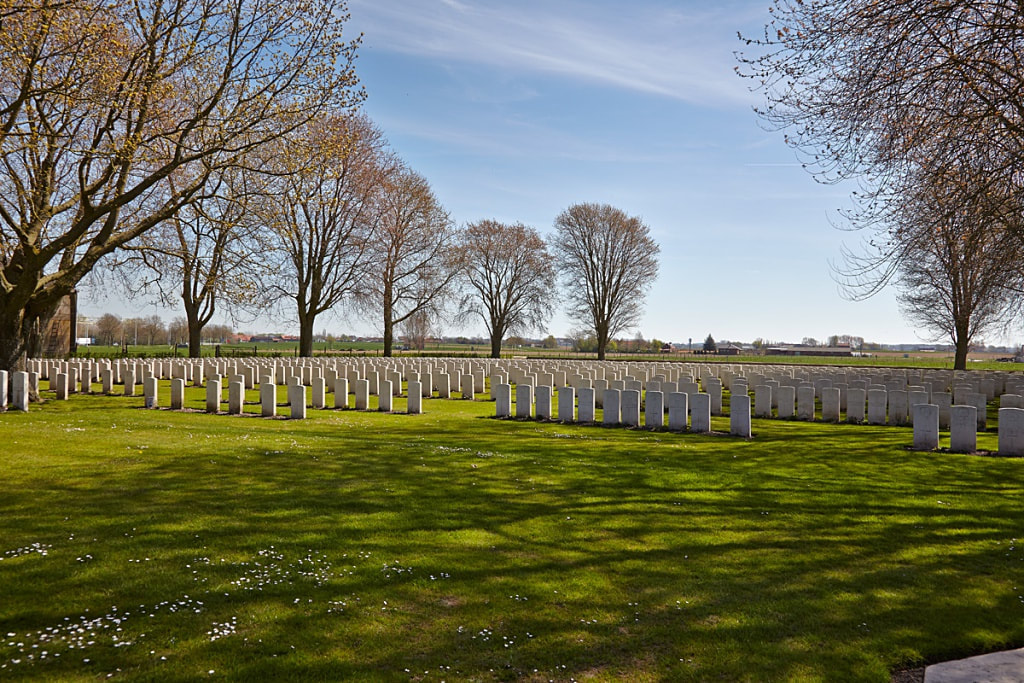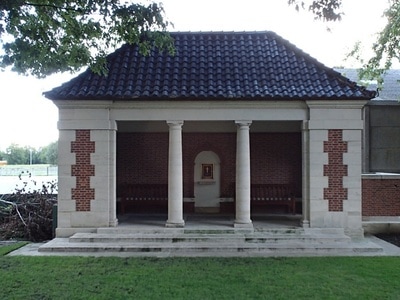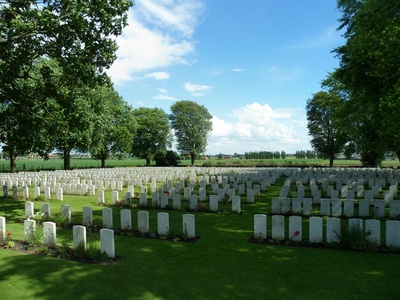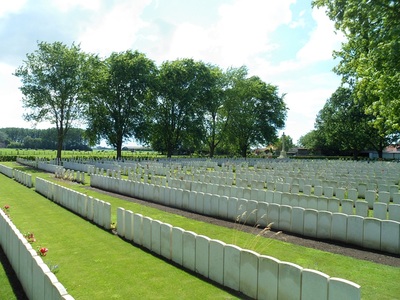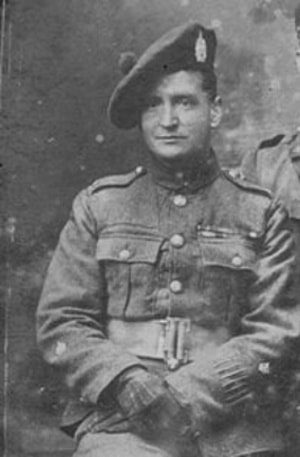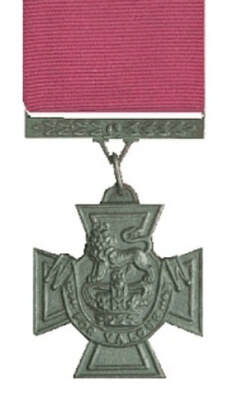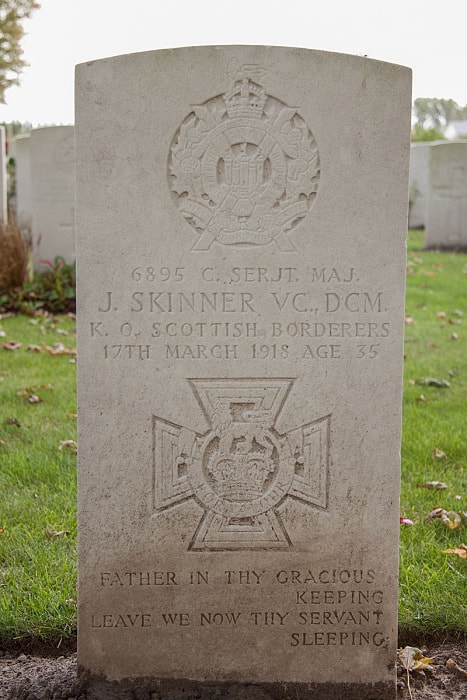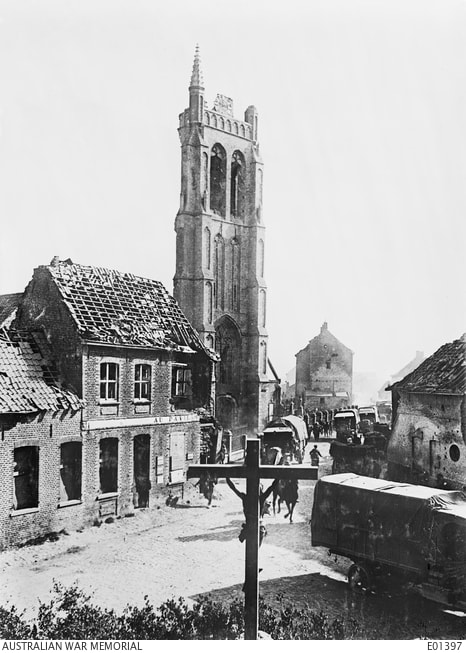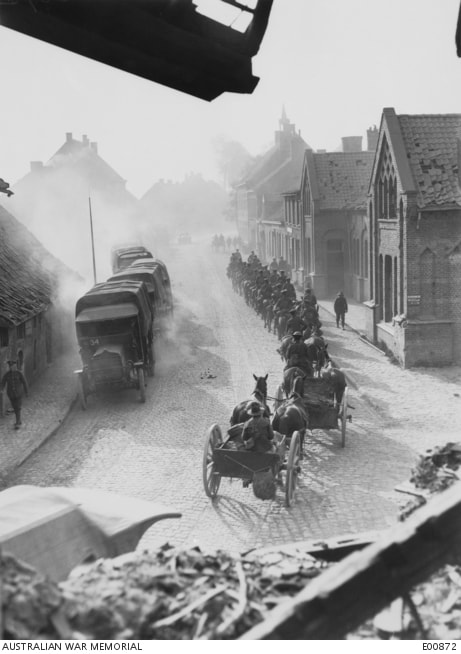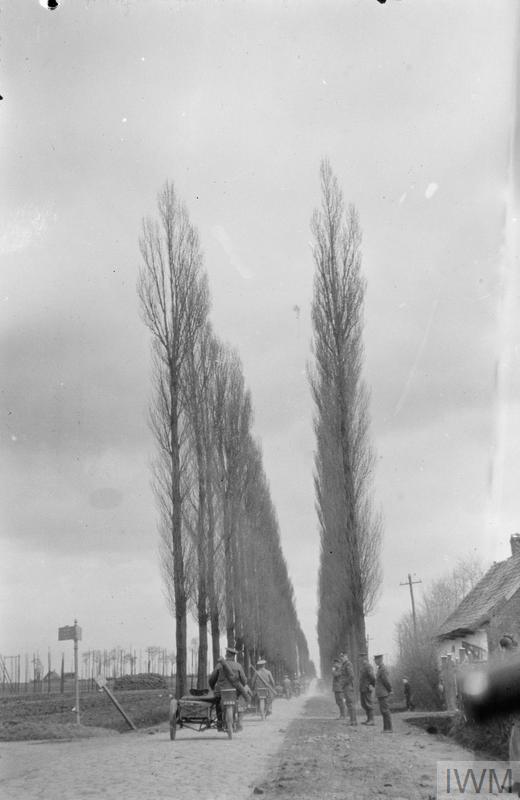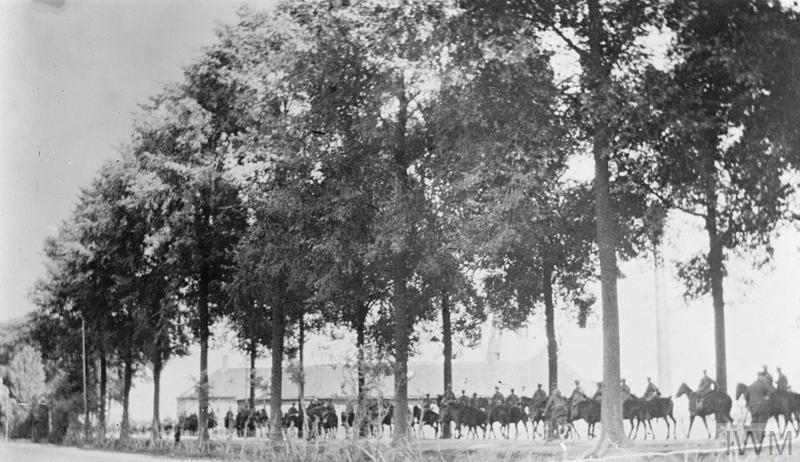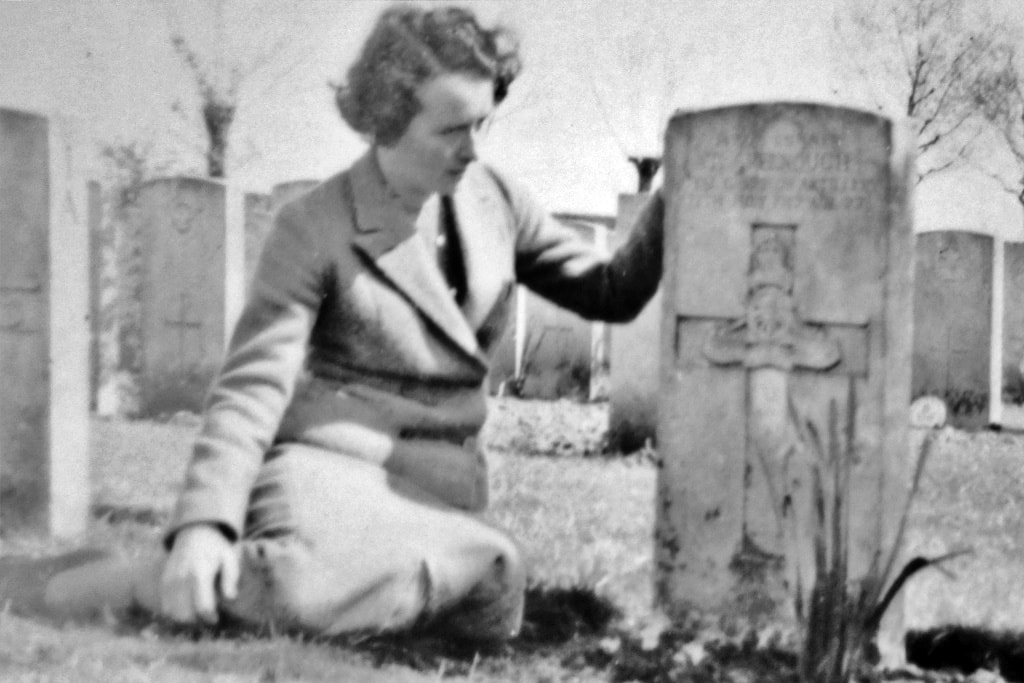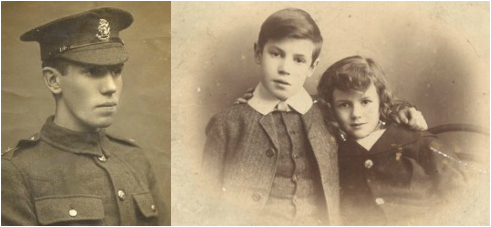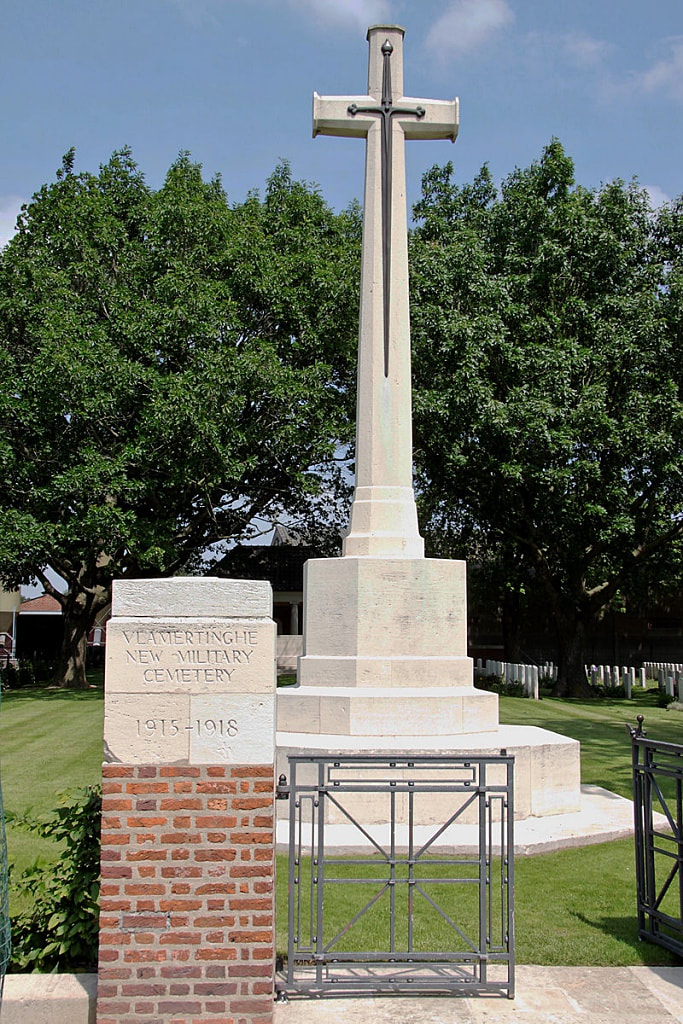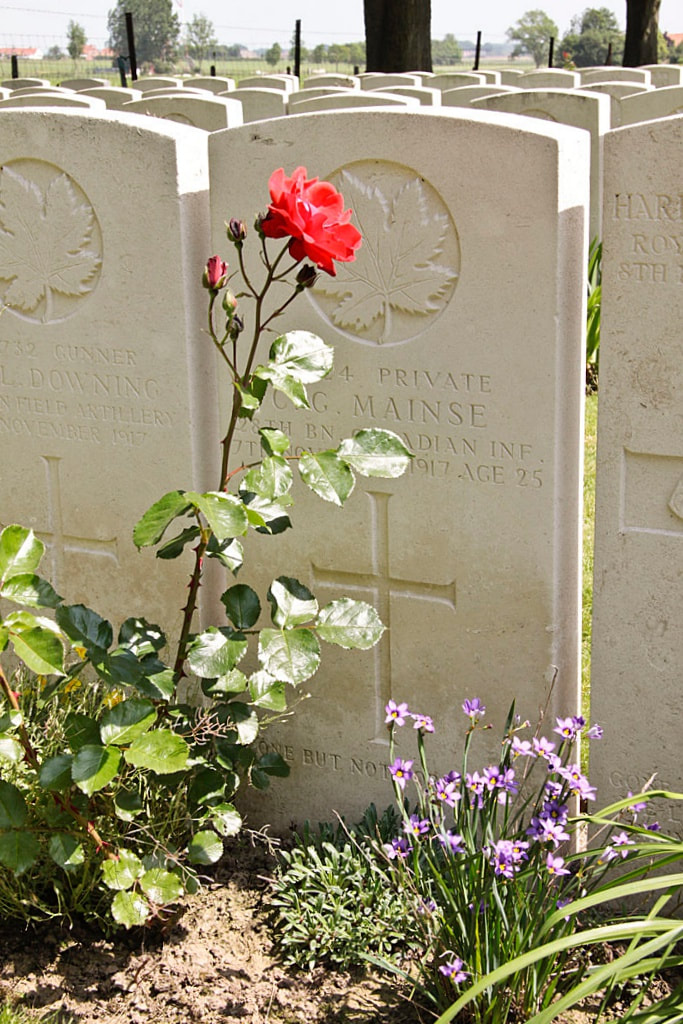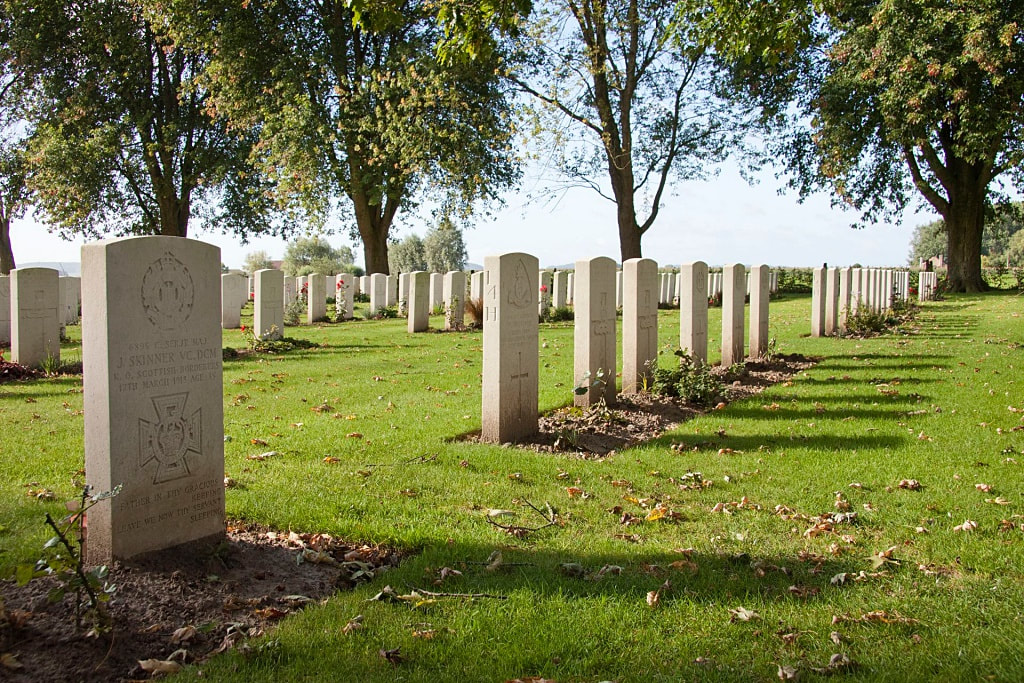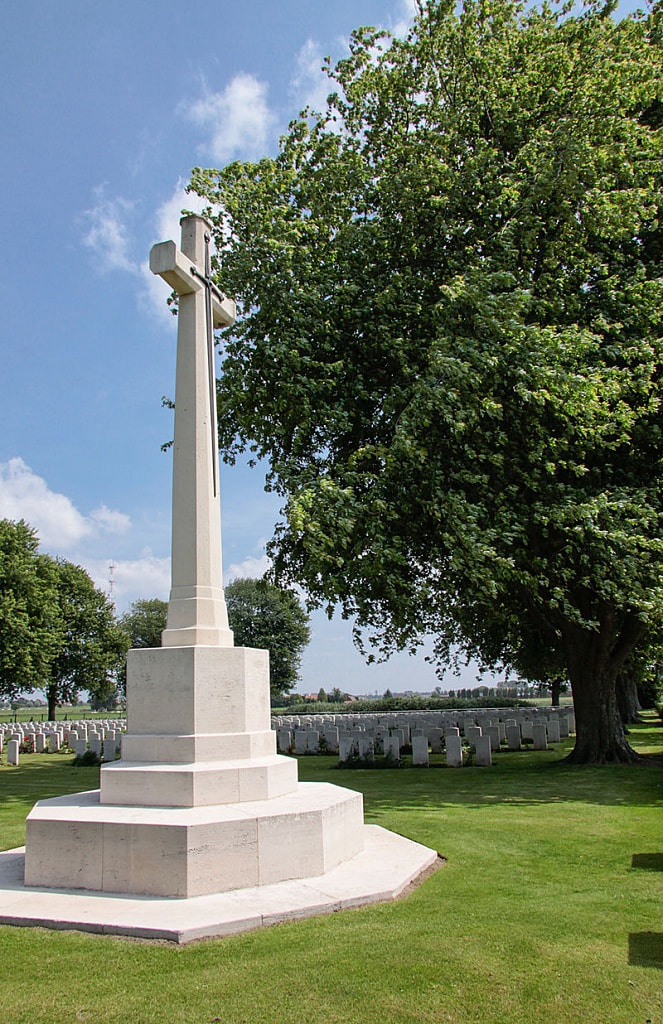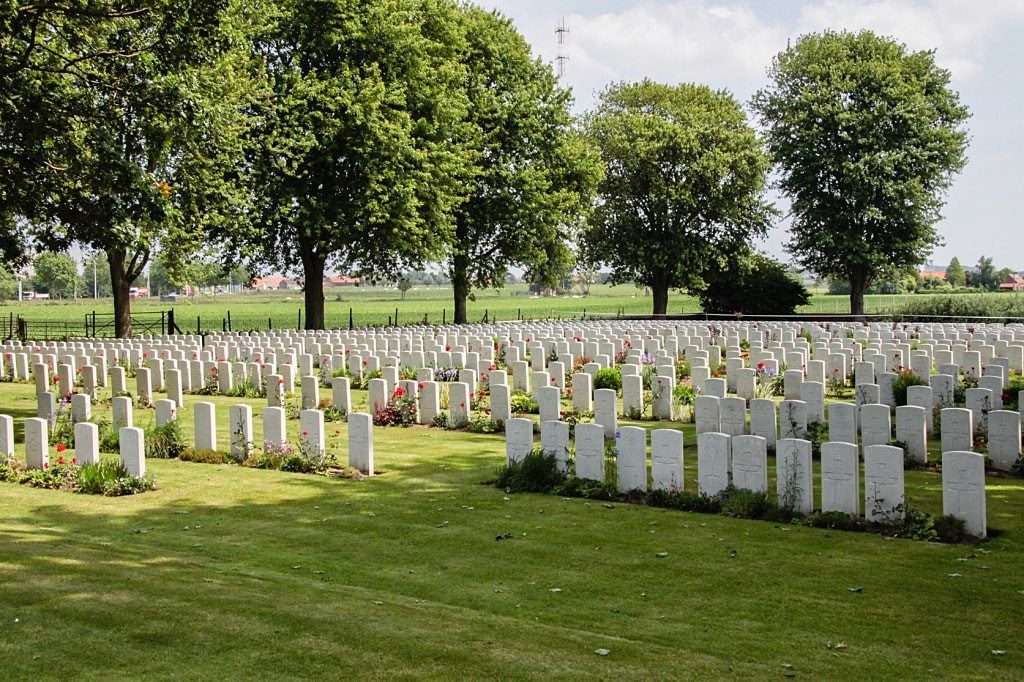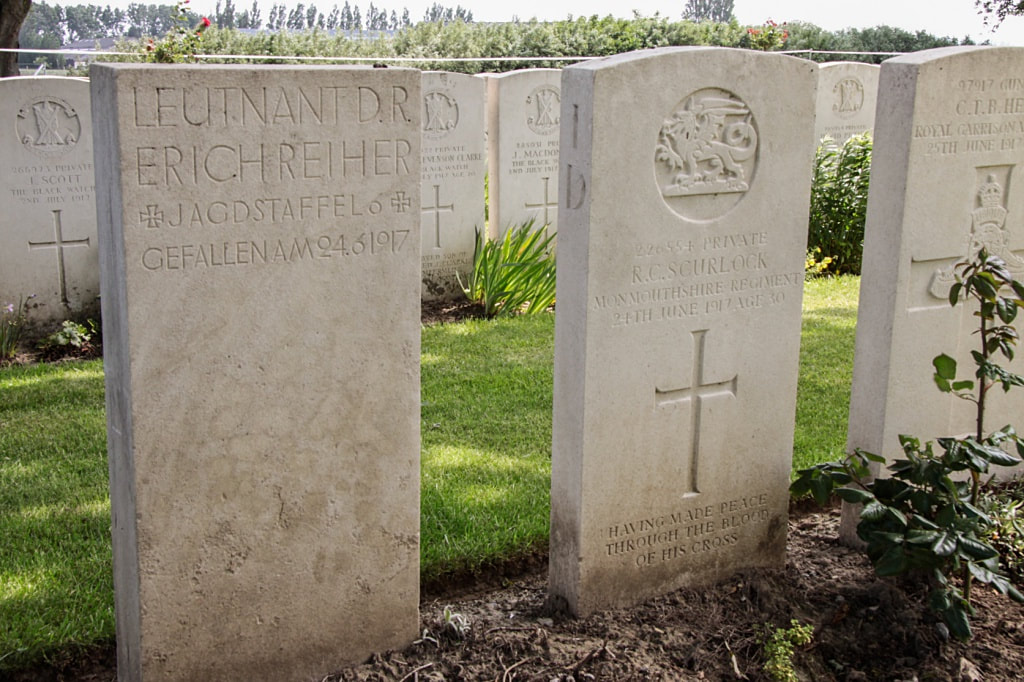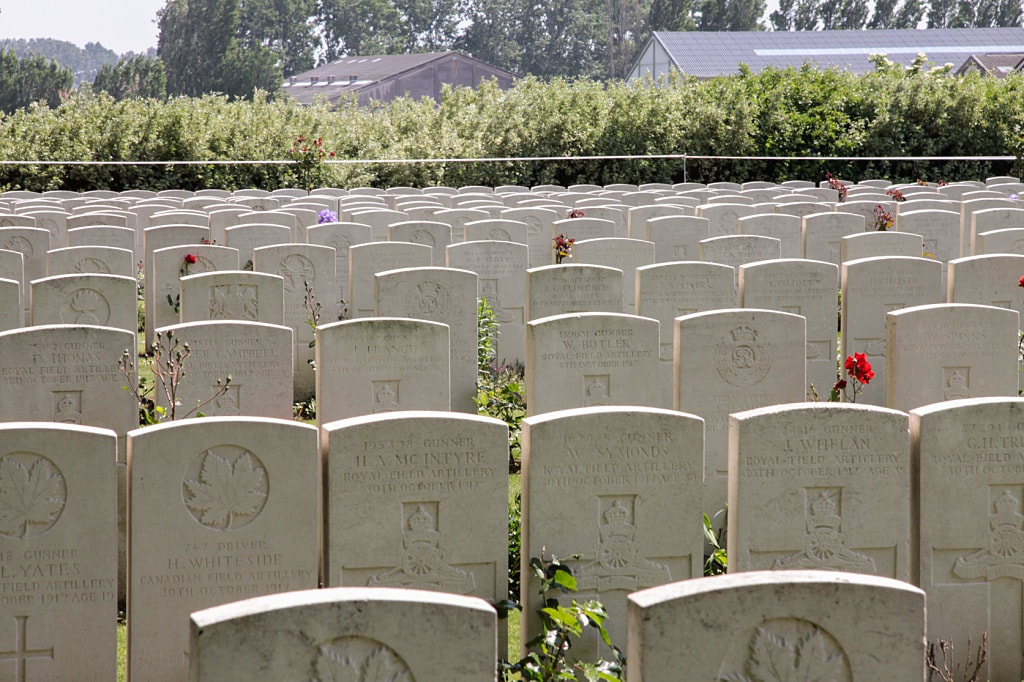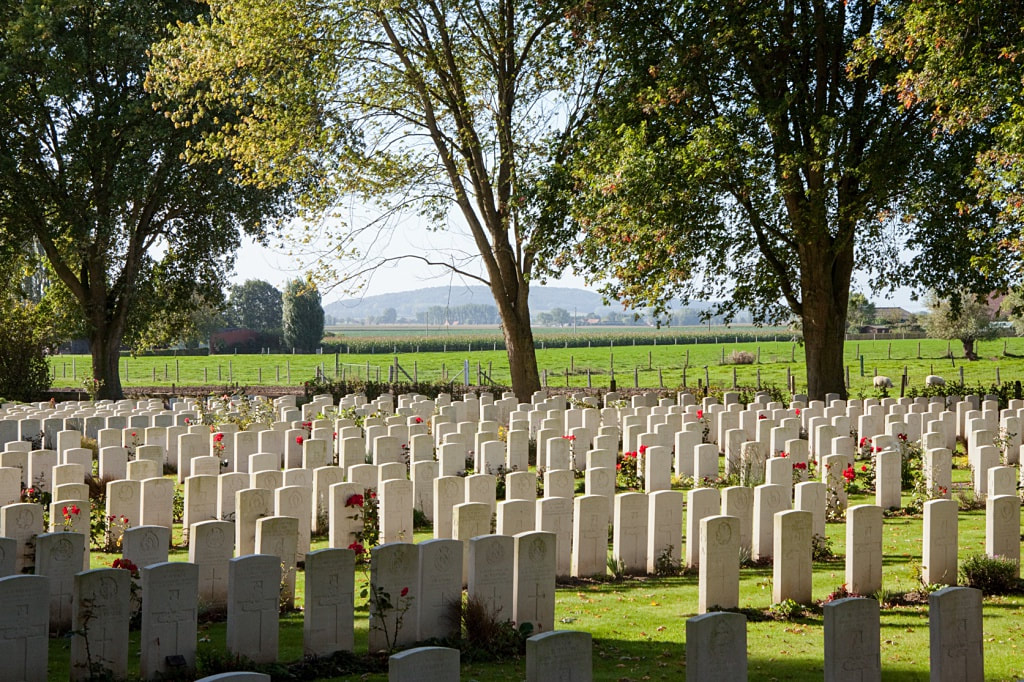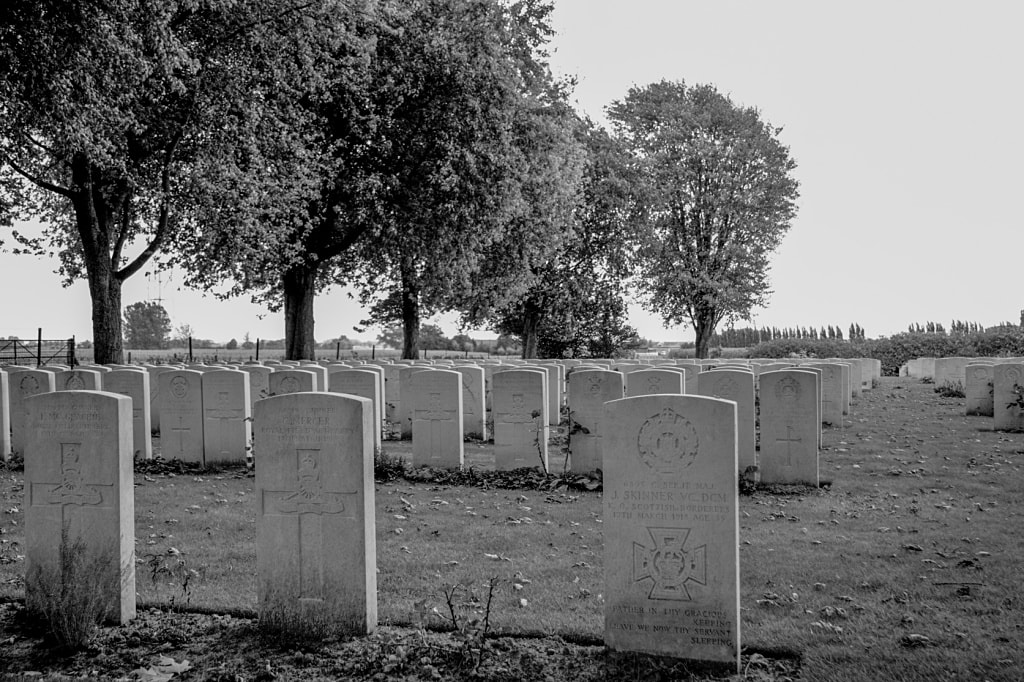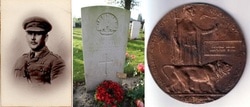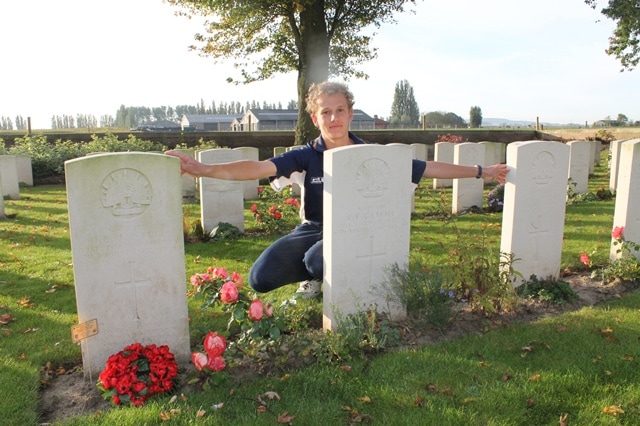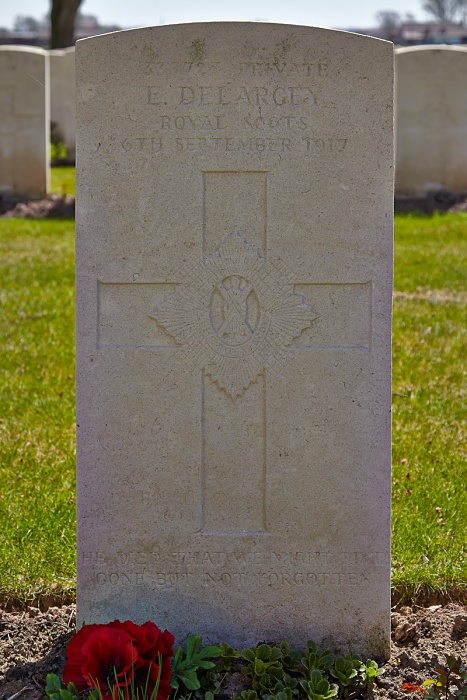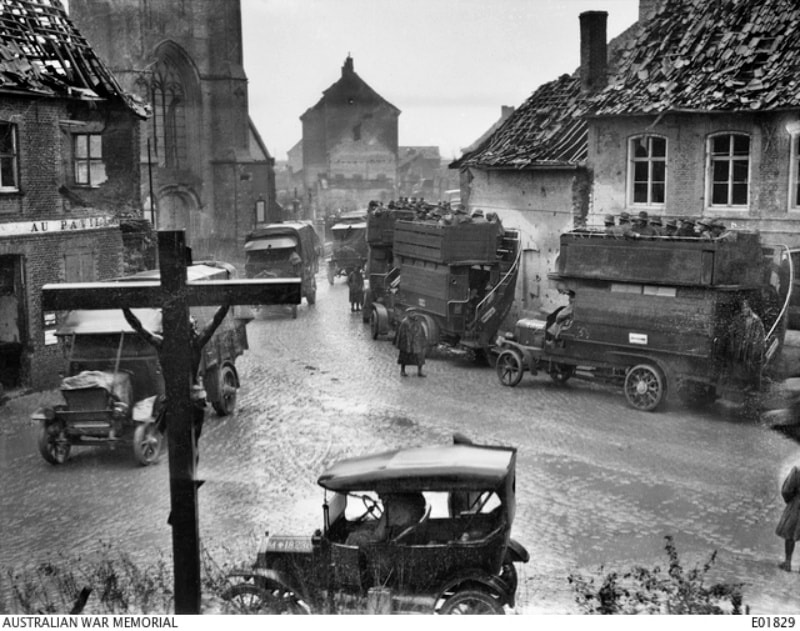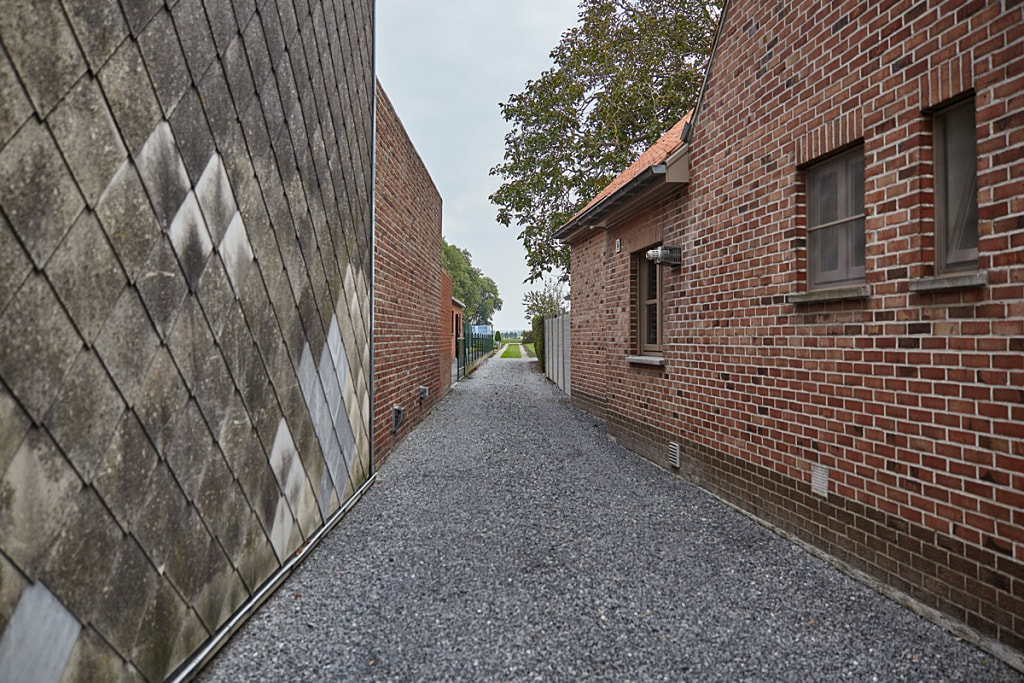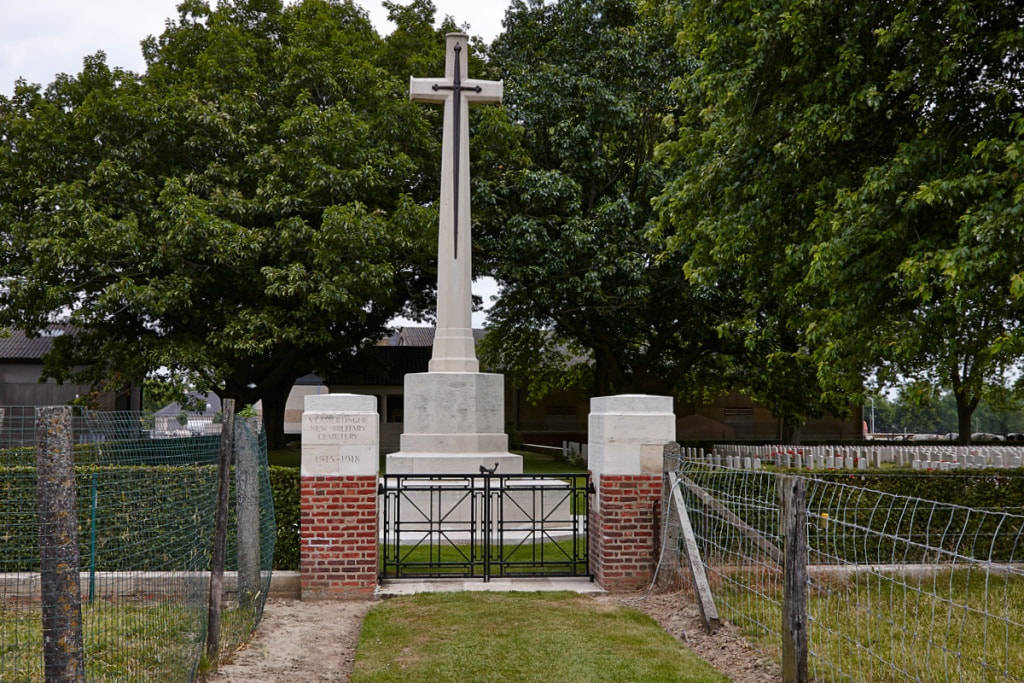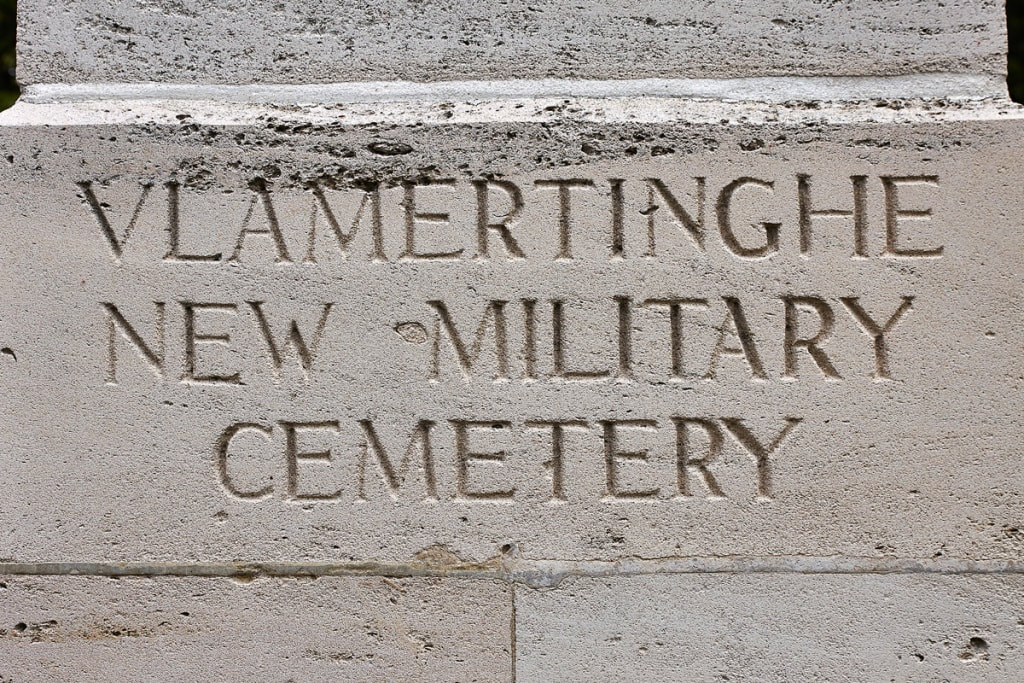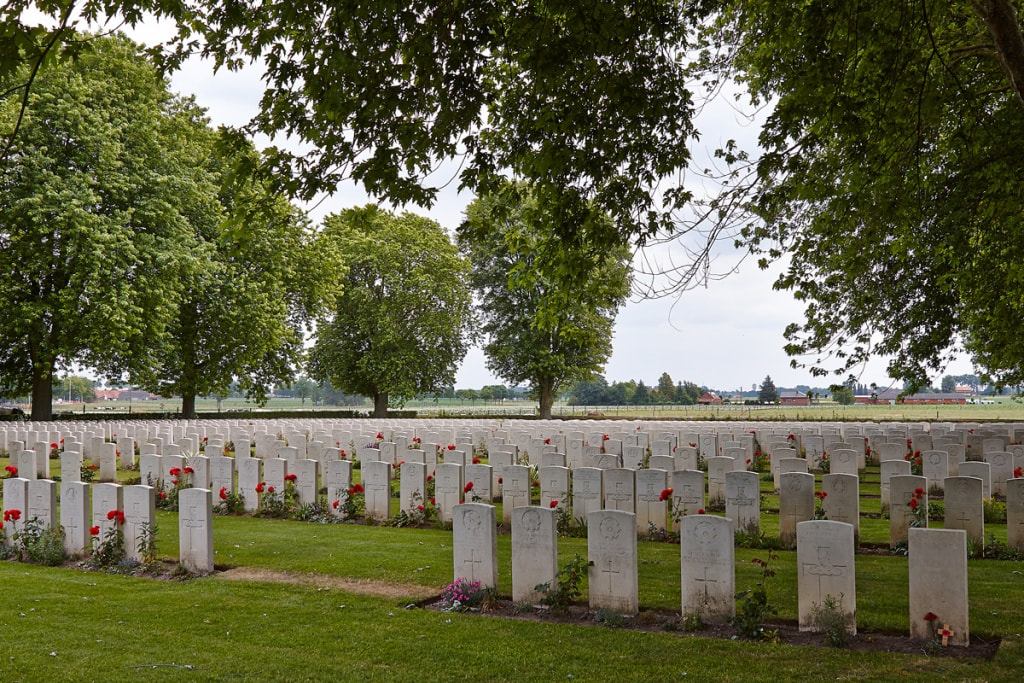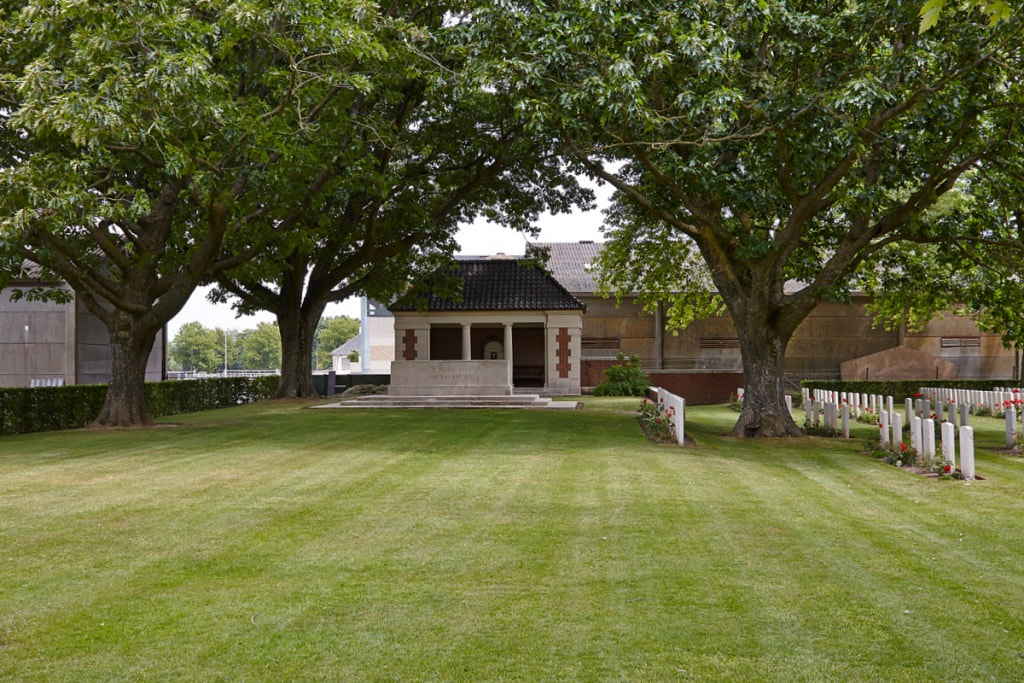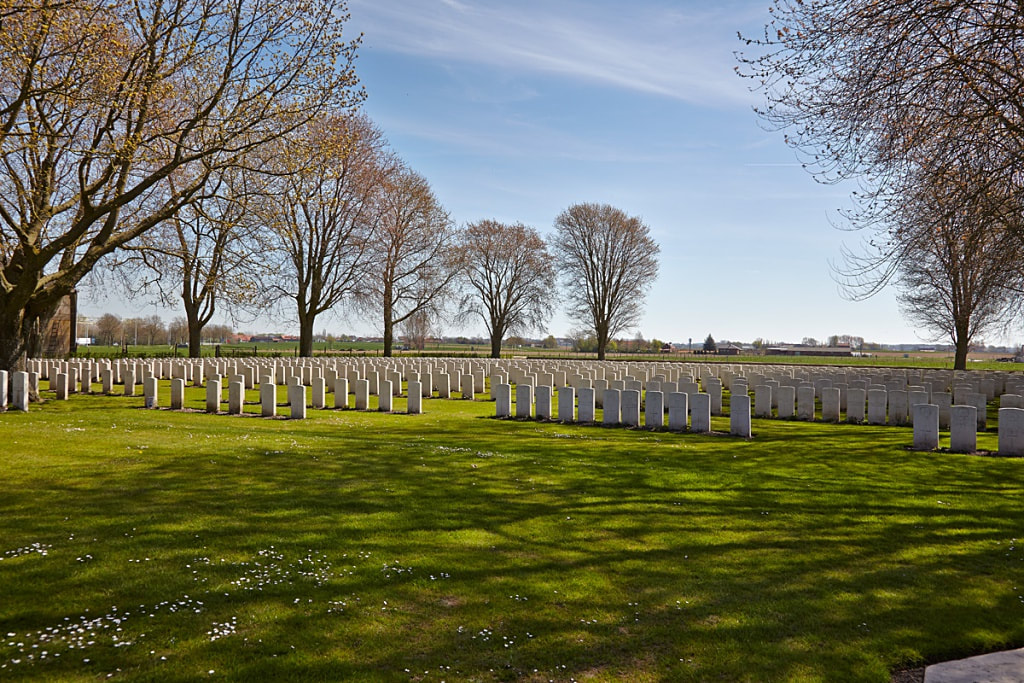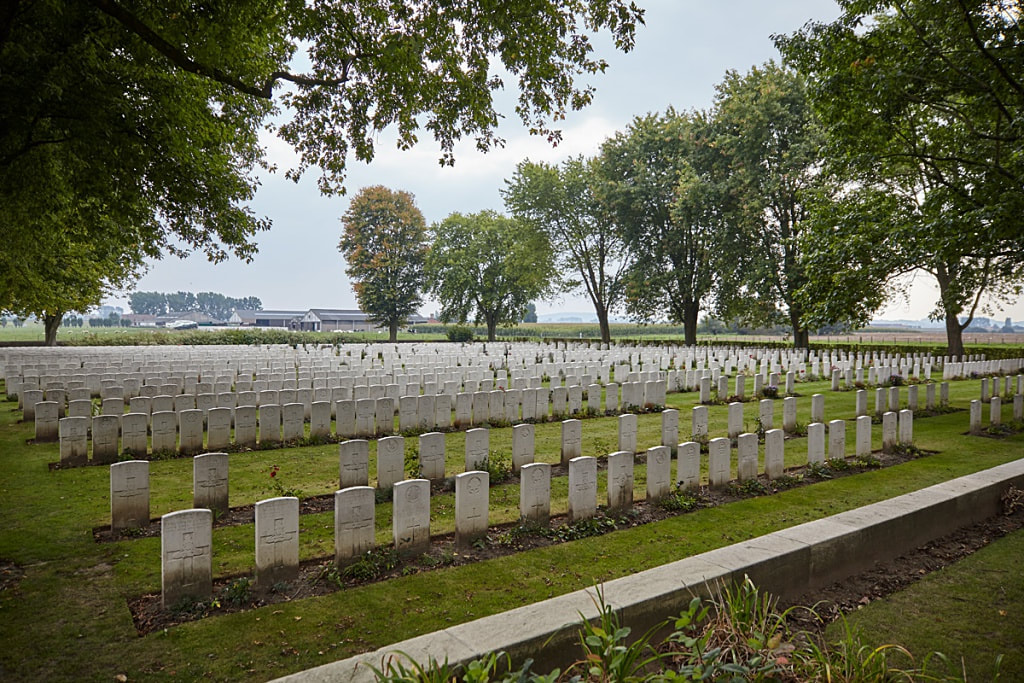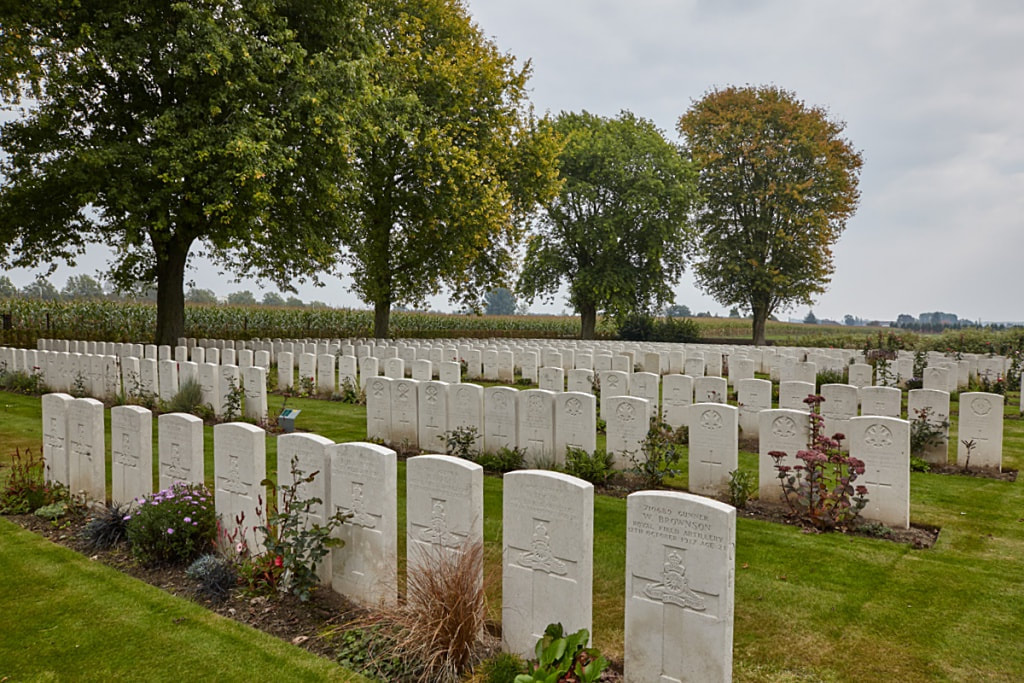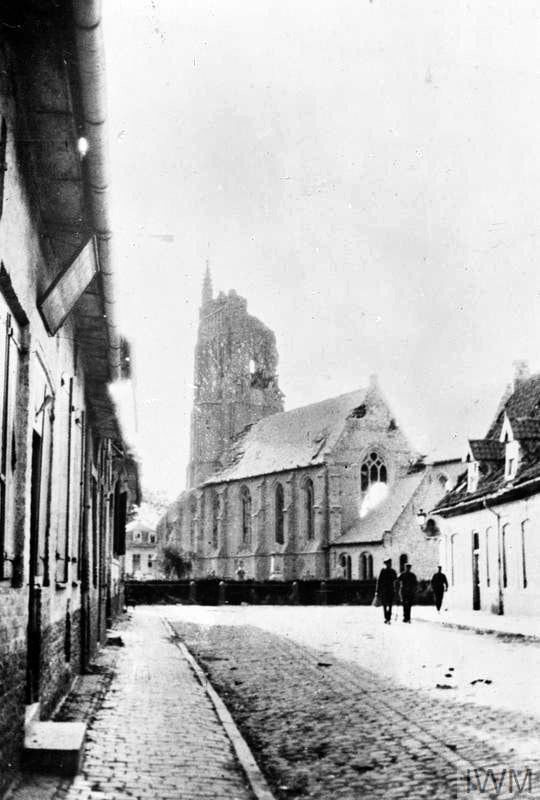VLAMERTINGHE NEW MILITARY CEMETERY
West-Vlaanderen
Belgium
GPS Coordinates - Latitude: 50.84772, Longitude: 2.81849
Location Information
Vlamertinghe New Military Cemetery is located 5 Kms west of Ieper town centre and to the south of the village of Vlamertinge (Vlamertinge is the modern spelling of Vlamertinghe). Vlamertinge is located along the Poperingseweg.
From Ieper town centre the Poperingseweg (N308), is reached via Elverdingsestraat then straight over two small roundabouts in the J. Capronstraat. The Poperingseweg is a continuation of J. Capronstraat and begins after a prominent railway level crossing.
The cemetery is located after turning left in the village of Vlamertinge onto the Hugo Verriestraat. This road crosses a railway and the main road N38, where the name of the street changes to Bellestraat. The cemetery lies 200 metres on the left hand side of the Bellestraat, after crossing the N38.
Visiting Information
Visitors to this site should note a grassed access path which runs between two houses on the street front and is unsuitable for vehicles.
Wheelchair access is possible via the main entrance.
Historical Information
For much of the First World War, Vlamertinghe (now Vlamertinge) was just outside the normal range of German shell fire and the village was used both by artillery units and field ambulances. Burials were made in the original Military Cemetery until June 1917, when the New Military Cemetery was begun in anticipation of the Allied offensive launched on this part of the front in July. Although the cemetery continued in use until October 1918, most of the burials are from July to December 1917.
The cemetery now contains 1,812 Commonwealth burials of the First World War.
Total Burials: 1,820.
Identified Casualties: United Kingdom 1,600, Canada 154, Australia 44, Germany 5, South Africa 3, New Zealand 1. Total 1,807.
Unidentified Casualties: 13.
The cemetery was designed by Sir Reginald Blomfield and John Reginald Truelove
Vlamertinghe New Military Cemetery is located 5 Kms west of Ieper town centre and to the south of the village of Vlamertinge (Vlamertinge is the modern spelling of Vlamertinghe). Vlamertinge is located along the Poperingseweg.
From Ieper town centre the Poperingseweg (N308), is reached via Elverdingsestraat then straight over two small roundabouts in the J. Capronstraat. The Poperingseweg is a continuation of J. Capronstraat and begins after a prominent railway level crossing.
The cemetery is located after turning left in the village of Vlamertinge onto the Hugo Verriestraat. This road crosses a railway and the main road N38, where the name of the street changes to Bellestraat. The cemetery lies 200 metres on the left hand side of the Bellestraat, after crossing the N38.
Visiting Information
Visitors to this site should note a grassed access path which runs between two houses on the street front and is unsuitable for vehicles.
Wheelchair access is possible via the main entrance.
Historical Information
For much of the First World War, Vlamertinghe (now Vlamertinge) was just outside the normal range of German shell fire and the village was used both by artillery units and field ambulances. Burials were made in the original Military Cemetery until June 1917, when the New Military Cemetery was begun in anticipation of the Allied offensive launched on this part of the front in July. Although the cemetery continued in use until October 1918, most of the burials are from July to December 1917.
The cemetery now contains 1,812 Commonwealth burials of the First World War.
Total Burials: 1,820.
Identified Casualties: United Kingdom 1,600, Canada 154, Australia 44, Germany 5, South Africa 3, New Zealand 1. Total 1,807.
Unidentified Casualties: 13.
The cemetery was designed by Sir Reginald Blomfield and John Reginald Truelove
895 Company Sergeant Major John Kendrick Skinner, V. C., D. C. M., Croix de Guerre (France),
1st Bn. King's Own Scottish Borderers
killed 17th March 1918, aged 35.
Plot XIII. H. 15.
Son of Walter Skinner; husband of Annie E. Y. Skinner, of 173, St. Andrew's Rd., Pollokshields, Glasgow. Native of Glasgow.
His headstone bears the inscription; "Father in thy gracious keeping leave we now thy servant sleeping"
Citation:
An extract from the Second Supplement to the London Gazette dated 14th Sept., 1917, recording the award of V.C., reads- "For most conspicuous bravery and good leading. Whilst his company was attacking, machine gun fire opened on the left flank, delaying the advance. Although C.S.M. Skinner was wounded in the head, he collected six men, and with great courage and determination worked round the left flank of three blockhouses from which the machine gun fire was coming, and succeeded in bombing and taking the first blockhouse single-handed; then, leading his six men towards the other two blockhouses, he skilfully cleared them, taking sixty prisoners, three machine guns, and two trench mortars. The dash and gallantry displayed by this warrant officer enabled the objective to be reached and consolidated."
Headstone
Second Lieutenant
Guy S. Ellis
Royal Flying Corps
12th July 1917, aged 19.
Plot I. G. 2
Pictures: Guy Ellis in the uniform if the Artists' Rifles and as a child with his brother
Born in Hull on 24th May 1898, GUY ELLIS was studying for his Intermediate Civil Service exam when, on 29th September 1915, he joined the London Regiment (Artists’ Rifles) at Dukes Road W.C. at the age of seventeen years 4 months. The medical showed that he was 5’ 7.5" with a 37" chest. His physical development was described as "fair".
Appointed Lance Corporal on 22nd April 1916, Guy had been languishing at Hare Hall Camp in Romford, Essex. He decided to apply for admission to an officer cadet unit with a view to getting a temporary commission for the duration of the war.
Question 3. "State in order of preference which branch of the Service......"
Guy wrote "Flying Corps" without hesitation.
His specific qualifications for the R.F.C. were considered by the selection board: "Rides a motorcycle (though not a horse); can sketch; slight knowledge of electricity; moderate knowledge of the internal combustion engine; knows the whole process of photography; had map reading course; maths 6 books of Euclid, Mechanics, Trigonometry, Algebra. Sports: first XI cricket and football at school; boxing; running (100 yds., ¼ mile, 220 yds., 120 yds., hurdles and high jump. Speaks French slightly".
Not perfect qualifications for a pilot perhaps, but knowledge of photography would be useful for an observer.
Guy was accepted at No.1 Officer Cadet Battalion at Denham in Bucks on 6th September 1916. From Denham, he was posted to Oxford reporting for duty there on 13th November.
He received his commission on 27th January 1917. The fact was noted in the London Gazette on 3rd February.
Holding the rank of temporary 2nd Lieutenant, he was seconded to 57 squadron stationed near Ypres. Here Guy settled down to the harrowing life of a young flying officer on active service. For most it was a pitifully short life, relieved only by drinking and joking in the mess in between sorties.
In July 1917 a new offensive at Ypres was planned. The aim was twofold; to break through the German lines and reach their submarine bases in Belgium, and to relieve the Russian army in the east.
The RFC was playing a significant role in the build up both in combat and in reconnaissance. On 11th July, some two weeks before the battle began, an allied air offensive involving 700 aircraft began. The following day, Thursday, one of these aircraft took off with Guy Ellis in the rear as observer. When he returned, he would have to think about settling his mess bill, now standing at £1-5-8.
It is not known whether it was a fighter or ground fire that hit Guy’s plane, but as it plummeted towards earth, the one thing that might have saved him was a parachute. But it was not policy to give airmen parachutes, "...possession of a parachute might impair a pilot’s nerve when in difficulties so that he would make improper use of his parachute…", was the official view.
And so 19 year old Guy was dead. The odds were stacked against him anyway, for by now the life expectancy of a junior officer in a front line squadron was anything from eleven days to three weeks.
Guy found his final resting place at Vlamertinghe New Military Cemetery in Belgium, "a sturdy wooden cross" marking the spot.
Guy S. Ellis
Royal Flying Corps
12th July 1917, aged 19.
Plot I. G. 2
Pictures: Guy Ellis in the uniform if the Artists' Rifles and as a child with his brother
Born in Hull on 24th May 1898, GUY ELLIS was studying for his Intermediate Civil Service exam when, on 29th September 1915, he joined the London Regiment (Artists’ Rifles) at Dukes Road W.C. at the age of seventeen years 4 months. The medical showed that he was 5’ 7.5" with a 37" chest. His physical development was described as "fair".
Appointed Lance Corporal on 22nd April 1916, Guy had been languishing at Hare Hall Camp in Romford, Essex. He decided to apply for admission to an officer cadet unit with a view to getting a temporary commission for the duration of the war.
Question 3. "State in order of preference which branch of the Service......"
Guy wrote "Flying Corps" without hesitation.
His specific qualifications for the R.F.C. were considered by the selection board: "Rides a motorcycle (though not a horse); can sketch; slight knowledge of electricity; moderate knowledge of the internal combustion engine; knows the whole process of photography; had map reading course; maths 6 books of Euclid, Mechanics, Trigonometry, Algebra. Sports: first XI cricket and football at school; boxing; running (100 yds., ¼ mile, 220 yds., 120 yds., hurdles and high jump. Speaks French slightly".
Not perfect qualifications for a pilot perhaps, but knowledge of photography would be useful for an observer.
Guy was accepted at No.1 Officer Cadet Battalion at Denham in Bucks on 6th September 1916. From Denham, he was posted to Oxford reporting for duty there on 13th November.
He received his commission on 27th January 1917. The fact was noted in the London Gazette on 3rd February.
Holding the rank of temporary 2nd Lieutenant, he was seconded to 57 squadron stationed near Ypres. Here Guy settled down to the harrowing life of a young flying officer on active service. For most it was a pitifully short life, relieved only by drinking and joking in the mess in between sorties.
In July 1917 a new offensive at Ypres was planned. The aim was twofold; to break through the German lines and reach their submarine bases in Belgium, and to relieve the Russian army in the east.
The RFC was playing a significant role in the build up both in combat and in reconnaissance. On 11th July, some two weeks before the battle began, an allied air offensive involving 700 aircraft began. The following day, Thursday, one of these aircraft took off with Guy Ellis in the rear as observer. When he returned, he would have to think about settling his mess bill, now standing at £1-5-8.
It is not known whether it was a fighter or ground fire that hit Guy’s plane, but as it plummeted towards earth, the one thing that might have saved him was a parachute. But it was not policy to give airmen parachutes, "...possession of a parachute might impair a pilot’s nerve when in difficulties so that he would make improper use of his parachute…", was the official view.
And so 19 year old Guy was dead. The odds were stacked against him anyway, for by now the life expectancy of a junior officer in a front line squadron was anything from eleven days to three weeks.
Guy found his final resting place at Vlamertinghe New Military Cemetery in Belgium, "a sturdy wooden cross" marking the spot.
A group of men from the Royal Garrison Artillery, all of whom hailed from Orkney, Thomas Harcus is pictured 3rd left and Andrew Harcus, 2nd right. And the graves of 7 men of the Royal Garrison Artillery, all killed on 03/08/1917, the grave of Thomas Harcus is 2nd left and his cousin Andrew is 2nd right. Pictures courtesy of Brian Budge of Orkney.
Images in this gallery © Werner Van Caneghem

Captain
Roy Hector Blashki, Mentioned in Despatches
53rd Battery, 14th Brigade, Australian Field Artillery
3rd August 1917, aged 23.
Plot VIII. C. 15.
INSCRIPTION. YOUNGER SON OF AARON AND MINNIE BLASHKI OF SYDNEY.
Son of Aaron and Minnie Blashki, of Sydney, New South Wales.
53 Battery, 14 Field Artillery Brigade, Australian Field Artillery Captain Blashki was born in Sydney, Australia and was studying law when war broke out in 1914. He enlisted with 10th Battery, Australian Field Artillery and received a commission shortly before leaving Australia on board RMS Persia on 10 August 1915. After a period in Egypt, Lt Blashki was posted to the Western Front in June 1916. There he was Mentioned in Despatches for his success in mounting an artillery barrage at great personal risk in November 1916, and also mentioned in Sir Douglas Haig's Despatch of 6 October 1917. Blashki was promoted to captain on 1 August 1917 but killed in action on the Menin Road at Ypres just two days later, aged 23.
Roy Hector Blashki, Mentioned in Despatches
53rd Battery, 14th Brigade, Australian Field Artillery
3rd August 1917, aged 23.
Plot VIII. C. 15.
INSCRIPTION. YOUNGER SON OF AARON AND MINNIE BLASHKI OF SYDNEY.
Son of Aaron and Minnie Blashki, of Sydney, New South Wales.
53 Battery, 14 Field Artillery Brigade, Australian Field Artillery Captain Blashki was born in Sydney, Australia and was studying law when war broke out in 1914. He enlisted with 10th Battery, Australian Field Artillery and received a commission shortly before leaving Australia on board RMS Persia on 10 August 1915. After a period in Egypt, Lt Blashki was posted to the Western Front in June 1916. There he was Mentioned in Despatches for his success in mounting an artillery barrage at great personal risk in November 1916, and also mentioned in Sir Douglas Haig's Despatch of 6 October 1917. Blashki was promoted to captain on 1 August 1917 but killed in action on the Menin Road at Ypres just two days later, aged 23.

91483 Gunner
Thomas Harcus
95th Siege Battery
Royal Garrison Artillery
3rd August 1917, aged 32.
Plot V. B. 35.
Husband of Ellen Rendall, he left two children and was a native of Westray, Orkney
Picture courtesy of Brian Budge of Orkney
Thomas Harcus
95th Siege Battery
Royal Garrison Artillery
3rd August 1917, aged 32.
Plot V. B. 35.
Husband of Ellen Rendall, he left two children and was a native of Westray, Orkney
Picture courtesy of Brian Budge of Orkney

91542 Gunner
Andrew Harcus
95th Siege Battery, Royal Garrison Artillery
3rd August 1917, aged 27.
Plot V.
Son of Andrew and Jessie Harcus; husband of Frances Harcus, of Dogtoo, Westray, Orkney. Native of Tirlot, Westray.
Plot V. B. 39.
Picture courtesy of Brian Budge of Orkney
Andrew Harcus
95th Siege Battery, Royal Garrison Artillery
3rd August 1917, aged 27.
Plot V.
Son of Andrew and Jessie Harcus; husband of Frances Harcus, of Dogtoo, Westray, Orkney. Native of Tirlot, Westray.
Plot V. B. 39.
Picture courtesy of Brian Budge of Orkney

16620 Gunner
Ben Hunt
76th Siege Bty. (90th Heavy Artillery Group), Royal Garrison Artillery
30th June 1917, aged 31.
Plot III. D. 4
Picture courtesy of grandson Brian Tucker
Ben Hunt
76th Siege Bty. (90th Heavy Artillery Group), Royal Garrison Artillery
30th June 1917, aged 31.
Plot III. D. 4
Picture courtesy of grandson Brian Tucker

121021 Gunner
G. T. Jordan
321st Siege Battery, Royal Garrison Artillery
3rd July 1917.
Plot I. E. 26.
G. T. Jordan
321st Siege Battery, Royal Garrison Artillery
3rd July 1917.
Plot I. E. 26.

23288 Corporal
William Murphy
13th Bde. Australian Field Artillery
10th October 1917, aged 26.
Plot IX. F. 19.
Son of James & Agnes Murphy. Much loved brother of May, Ellen, Agnes & Jim and a much loved husband of Maud (nee Hennessey)
The memorial card sent out by his family read:
“If we could have clasped his dying hand
And heard his last farewell,
It would have not been so hard to part
With the one we loved so well.
We often pictured our Will returning
And we longed to clasp his hand.
But death has postponed our meeting
Until we meet in a better land.”
Picture courtesy of Donna Costello, great niece
William Murphy
13th Bde. Australian Field Artillery
10th October 1917, aged 26.
Plot IX. F. 19.
Son of James & Agnes Murphy. Much loved brother of May, Ellen, Agnes & Jim and a much loved husband of Maud (nee Hennessey)
The memorial card sent out by his family read:
“If we could have clasped his dying hand
And heard his last farewell,
It would have not been so hard to part
With the one we loved so well.
We often pictured our Will returning
And we longed to clasp his hand.
But death has postponed our meeting
Until we meet in a better land.”
Picture courtesy of Donna Costello, great niece
Medallion issued to Oswald's family after his death.
Life Stories
The Life and Times of Oswald Leslie Jennings Steel
By Christopher Albertson
Life Stories
The Life and Times of Oswald Leslie Jennings Steel
By Christopher Albertson
Oswald Leslie Jennings Steel was born on August 7th 1883 in Newcastle, New South Wales. He was the eldest child of Oswald Gleghorn and Elizabeth Ann Steel (nee Jennings). He had two siblings, a brother Cecil and a sister Essie. Oswald studied Physics and Chemistry at Sydney University, now known as the University of Sydney and became a teacher at Cleveland Street Public, where he was a Science Master. He was a talented musician and led his choir in a leading part in the welcome to the officers and men of the American fleet at Sydney Town Hall in 1908, he himself at the grand organ. On October 16th 1907 he married Bertha Amy Hooker in Paddington, Sydney and they had three children, Beryl, Leslie and Geoffrey.
Oswald enlisted in Sydney as an officer in the AIF on September 23rd 1914 and was commissioned as a 2nd Lieutenant on October 31st. He had previously done three years commissioned service with the Senior Cadets and at his time of enlistment was serving as the Battery Captain of the 17th Battery, Australian Fortress Artillery. He was initially posted to the 15th Battery, 5th Australian Field Artillery, AIF.
On December 22nd 1914 he embarked with the 1st Reinforcement to the 1st Divisional Ammunition Column from Melbourne aboard HMAT Borda, and joined the Mediterranean Expeditionary Force on April 4th 1915. He was among the first to land at ANZAC Cove and served at Gallipoli with the 1st Field Artillery and later at Cape Helles. Oswald was commissioned to make sketches of the enemy trenches from the forward observation trenches some miles in advance of the main line. Whilst there his communication lines were cut, his three companions killed and he was not rescued until four days later with no company but their bodies. By this time he was stricken with enteric and sent back to Australia for three months convalescence. During his recovery period in Australia he performed the role of Acting Adjutant to the artillery camp at National Park, although he was under no obligation to do this. On July 1st 1915 he was promoted to the rank of Lieutenant.
Once Oswald was fit enough to return to duty, he re-embarked with his younger brother Cecil, a Corporal. They embarked together with the 5th Field Artillery from Sydney on November 18th 1915 aboard HMAT Persic, where they disembarked in Egypt on December 21st. Oswald was promoted to Captain in March of 1916 and later was transferred to the 15th Field Artillery headquarters as Adjutant, arriving in France with his unit on June 24th. He served at headquarters until being transferred to the 57th Battery in the field on December 31st. On February 2nd 1917 he was temporarily attached to the 5th Divisional Ammunition Column, and on March 17th he was placed in temporary command on No.1 Section of the 5th DAC. In early June 1917 was placed in temporary command of the entire 5th Divisional Ammunition Column of the British Expeditionary Force.
He was taken on strength with the 14th Field Artillery on July 29th 1917, when the 5th DAC was absorbed into the 14th Field Artillery. It was a move which ultimately cost Oswald his life eight days later. Tragically, Oswald died only a few hours before his 34th birthday, when a shell destroyed his dugout. His CO reported that Oswald “was killed at 55th Battery position off Menin Road in front of Ypres at about 9pm on August 6th 1917. A shell penetrated the dugout occupied by this officer, totally destroying the dugout and killing all occupants immediately.” Oswald and his two fellow officers who were killed with him, Lieutenant Joseph Hopper and Captain Frank Edward Gatliff, were buried side by side at Vlamertinghe New Military Cemetery, 2¾ miles west of Ypres the following day, Oswald’s 34th birthday, by Chaplain Reverend P.S. Moore. At the time of his death Oswald was in command of the New South Wales detachment of his division in the field.
Oswald left behind his wife Bertha and children Beryl, Leslie and Geoffrey, who was only just 3 months old when Oswald embarked for the war. His brother Cecil also served in the 14th Field Artillery in July and August of 1917, and was in the unit at the time of Oswald’s death. Cecil survived the war despite being wounded in action and was discharged in 1919 with the rank of Battery Quartermaster Sergeant
Oswald enlisted in Sydney as an officer in the AIF on September 23rd 1914 and was commissioned as a 2nd Lieutenant on October 31st. He had previously done three years commissioned service with the Senior Cadets and at his time of enlistment was serving as the Battery Captain of the 17th Battery, Australian Fortress Artillery. He was initially posted to the 15th Battery, 5th Australian Field Artillery, AIF.
On December 22nd 1914 he embarked with the 1st Reinforcement to the 1st Divisional Ammunition Column from Melbourne aboard HMAT Borda, and joined the Mediterranean Expeditionary Force on April 4th 1915. He was among the first to land at ANZAC Cove and served at Gallipoli with the 1st Field Artillery and later at Cape Helles. Oswald was commissioned to make sketches of the enemy trenches from the forward observation trenches some miles in advance of the main line. Whilst there his communication lines were cut, his three companions killed and he was not rescued until four days later with no company but their bodies. By this time he was stricken with enteric and sent back to Australia for three months convalescence. During his recovery period in Australia he performed the role of Acting Adjutant to the artillery camp at National Park, although he was under no obligation to do this. On July 1st 1915 he was promoted to the rank of Lieutenant.
Once Oswald was fit enough to return to duty, he re-embarked with his younger brother Cecil, a Corporal. They embarked together with the 5th Field Artillery from Sydney on November 18th 1915 aboard HMAT Persic, where they disembarked in Egypt on December 21st. Oswald was promoted to Captain in March of 1916 and later was transferred to the 15th Field Artillery headquarters as Adjutant, arriving in France with his unit on June 24th. He served at headquarters until being transferred to the 57th Battery in the field on December 31st. On February 2nd 1917 he was temporarily attached to the 5th Divisional Ammunition Column, and on March 17th he was placed in temporary command on No.1 Section of the 5th DAC. In early June 1917 was placed in temporary command of the entire 5th Divisional Ammunition Column of the British Expeditionary Force.
He was taken on strength with the 14th Field Artillery on July 29th 1917, when the 5th DAC was absorbed into the 14th Field Artillery. It was a move which ultimately cost Oswald his life eight days later. Tragically, Oswald died only a few hours before his 34th birthday, when a shell destroyed his dugout. His CO reported that Oswald “was killed at 55th Battery position off Menin Road in front of Ypres at about 9pm on August 6th 1917. A shell penetrated the dugout occupied by this officer, totally destroying the dugout and killing all occupants immediately.” Oswald and his two fellow officers who were killed with him, Lieutenant Joseph Hopper and Captain Frank Edward Gatliff, were buried side by side at Vlamertinghe New Military Cemetery, 2¾ miles west of Ypres the following day, Oswald’s 34th birthday, by Chaplain Reverend P.S. Moore. At the time of his death Oswald was in command of the New South Wales detachment of his division in the field.
Oswald left behind his wife Bertha and children Beryl, Leslie and Geoffrey, who was only just 3 months old when Oswald embarked for the war. His brother Cecil also served in the 14th Field Artillery in July and August of 1917, and was in the unit at the time of Oswald’s death. Cecil survived the war despite being wounded in action and was discharged in 1919 with the rank of Battery Quartermaster Sergeant
Oswald and his two fellow officers killed in the same dugout by the same shell, buried side by side.

104241 Private
James Scholfield
87th Field Ambulance, Royal Army Medical Corps
4th April 1918, aged 34.
Plot XV. H. 6.
Son of Robert and Martha Scholfield; husband of Maggie Scholfield, of 82, Healey Wood Rd., Burnley. Native of Burnley.
James Scholfield
87th Field Ambulance, Royal Army Medical Corps
4th April 1918, aged 34.
Plot XV. H. 6.
Son of Robert and Martha Scholfield; husband of Maggie Scholfield, of 82, Healey Wood Rd., Burnley. Native of Burnley.

87294 Gunner
George Henry Trull
117th Battery, Royal Field Artillery
30th October 1917
Plot IX. E. 11.
Picture courtesy of great nephew John Eeley
George Henry Trull
117th Battery, Royal Field Artillery
30th October 1917
Plot IX. E. 11.
Picture courtesy of great nephew John Eeley
Shot at Dawn
335727 Private Edward Delargy, 1st/8th Bn. Royal Scots, executed for desertion, 6th September 1917, aged 19. Plot IX. H. 19. Son of Mrs. Winnifred Delargy, of 42, Mount Pleasant, Leslie, Fife. He had already been sentenced to 112 days’ detention, seemingly before being sent to France. When his (Pioneer) battalion was working on the Arras front, he spent a week in the care of Field Ambulance unit. Upon his discharge, when he was given a pass to a village 2 miles away, he disappeared — only to be arrested 6 months later some 10 miles from Arras. (Putkowski, pp.190-191)
335727 Private Edward Delargy, 1st/8th Bn. Royal Scots, executed for desertion, 6th September 1917, aged 19. Plot IX. H. 19. Son of Mrs. Winnifred Delargy, of 42, Mount Pleasant, Leslie, Fife. He had already been sentenced to 112 days’ detention, seemingly before being sent to France. When his (Pioneer) battalion was working on the Arras front, he spent a week in the care of Field Ambulance unit. Upon his discharge, when he was given a pass to a village 2 miles away, he disappeared — only to be arrested 6 months later some 10 miles from Arras. (Putkowski, pp.190-191)

